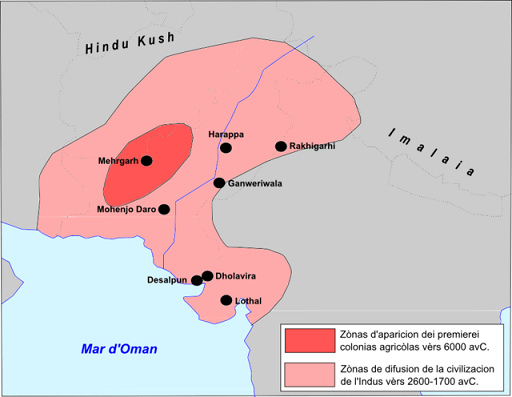The Harappan Civilisation was not a combination of recently immigrated Central Asians, Iranians or Mesopotamians which imported civilizational knowledge, but instead was a distinct group which ກ່ຽວກັບພັນທຸກໍາ diverged long before the advent of HC. Furthermore, due to the suggested genetic distinctness of the HC, it seems unlikely that language in that geographical region was imported by an Indo-European group as is often theorised. Lastly, the study demonstrates that the DNA of HC inhabitants had little contribution from Central and West Asians but did have a contribution to modern South Asian genetics.
ພົນລະເຮືອນ Harappan (HC), ອະດີດເອີ້ນວ່າອາລະຍະທໍາຂອງ Indus Valley, ແມ່ນຫນຶ່ງໃນທໍາອິດ ພົນລະເມືອງ to independently arise. HC became “mature” at around 2600BCE; having meticulously planned towns with complex drainage systems, and wide scale standardisation of weights and measures. The civilisation was by far the biggest in its era, with HC including most of northwest South Asia. The genetic analysis conducted of an ancient woman called “Rakhigarhi woman” (named after the modern town in India in which her remains were found), estimated to have lived between 2300 and 2800BCE in an HC town, sheds light on the ancestors and possible descendants of the individuals who lived in HC.
DNA mitochondrial ຂອງແມ່ຍິງບູຮານນີ້ໄດ້ຖືກຈັດລໍາດັບເຊັ່ນກັນ. ໄມໂທຄອນ haplogroup (this indicates a common ancestor on a genetic lineage) was U2b2, which is not a haplogroup found in ancient mitochondrial genomes of Central Asians suggesting that this women was native to the HC region and was not ກ່ຽວກັບພັນທຸກໍາ a migrant from Central Asia. Furthermore, this haplogroup is found almost exclusively in modern South Asia suggesting that modern South Asians may descend either from the individuals who were part of HC or may share similar ancestral lineage to them.
The Rakhigarhi woman’s DNA was also significantly different from DNA ບູຮານ found in Turkmenistan (Bronze Age Gonur) and Iran (Shahr-i-Sokhta) from around the same time period, but surprisingly it has differences with DNA of modern South Asians suggesting that modern South Asians may have descended from similar lineages that the HC descended from or that the genetics of South Asians may have evolved since the HC.
The ancient woman’s DNA is uniquely diverged. HC ancestry is believed to have 13% DNA which is diverged from common ancestry with the South-East Asian hunter-gatherers (Andamanese) and farmers (Dai) perhaps 15 to 20 thousand years ago; the rest 87% is diverged from common ancestry with Iranian hunter-gatherers, herders and farmers perhaps 10 to 15 thousand years ago. This suggests that the HC was not a combination of recently immigrated Central Asians, Iranians or Mesopotamians which imported civilizational knowledge, but instead was a distinct group which ກ່ຽວກັບພັນທຸກໍາ diverged long before the advent of HC. Furthermore, due to the suggested genetic distinctness of the HC, it seems unlikely that language in that geographical region was imported by an Indo-European group as is often theorised. Lastly, the study demonstrates that the DNA of HC inhabitants had little contribution from Central and West Asians but did have a contribution to modern South Asian genetics.
***
ທີ່ມາ:
Shinde V., Narasimhan V., et al 2019. Genome Harappan ວັດຖຸບູຮານຂາດບັນພະບຸລຸດຈາກນັກລ້ຽງສັດ Steppe ຫຼືຊາວກະສິກອນອີຣ່ານ. ເຊລ. ສະບັບທີ 179, ສະບັບທີ 3, P729-735.E10, ວັນທີ 17 ຕຸລາ 2019. ຈັດພີມມາ: 05 ກັນຍາ 2019. DOI: https://doi.org/10.1016/j.cell.2019.08.048
***






































